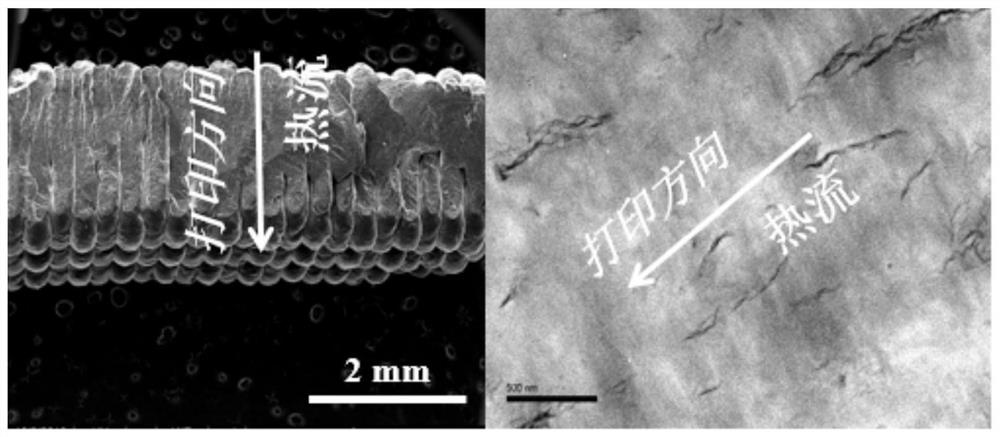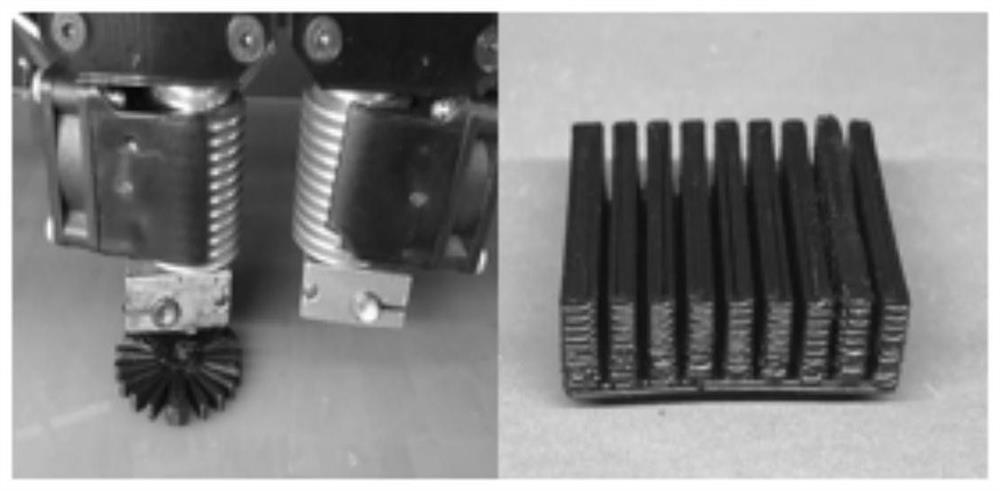A method for preparing 3D printed parts with high interplane thermal conductivity
A thermal conductivity, 3D printing technology, applied in 3D object support structures, manufacturing tools, additive manufacturing, etc., can solve problems such as low thermal conductivity, discussion research, filament verification, etc., to achieve improved mechanical properties and good filler dispersion , The effect of reducing the interface thermal resistance
- Summary
- Abstract
- Description
- Claims
- Application Information
AI Technical Summary
Problems solved by technology
Method used
Image
Examples
Embodiment 1
[0052] This embodiment adopts a method for preparing a 3D printed part with high thermal conductivity between surfaces, which includes the following steps in parts by weight:
[0053] (1) After mixing 100 parts of low-density polyethylene and 20 parts of graphene nanosheets, add them to a disc-shaped mechanochemical reactor for grinding and pulverization. After the grinding is completed, collect carbon-based fillers and evenly disperse them in the polymer matrix. Composite material powder; among them, the process parameters of the disc-shaped mechanochemical reactor are: the grinding pressure is 30MPa, the temperature of the disc surface is controlled by feeding a constant temperature circulating liquid medium with a temperature of 35°C, cyclic grinding 6 times, and the disc rotation speed 30r / min;
[0054] (2) Extrude the composite material powder obtained in step (1) to obtain a filament for 3D printing. The extrusion processing parameters are: extrusion temperature 170°C, ...
Embodiment 2
[0064] This embodiment adopts a method for preparing a 3D printed part with high thermal conductivity between surfaces, which includes the following steps in parts by weight:
[0065] (1) After mixing 100 parts of low-density polyethylene and 20 parts of carbon nanotubes, they are added to a disc-shaped mechanochemical reactor for grinding and pulverization. After the grinding is completed, carbon-based fillers are collected and evenly dispersed in the polymer matrix. Material powder; among them, the process parameters of the disc-shaped mechanochemical reactor are as follows: the grinding pressure is 25MPa, the temperature of the disc surface is controlled by feeding a constant temperature circulating liquid medium with a temperature of 35°C, and the grinding cycle is 6 times, and the rotational speed of the disc is 30r / min;
[0066] (2) Extrude the composite material powder obtained in step (1) to obtain a filament for 3D printing. The extrusion processing parameters are: e...
Embodiment 3
[0076] This embodiment adopts a method for preparing a 3D printed part with high thermal conductivity between surfaces, which includes the following steps in parts by weight:
[0077] (1) After mixing 100 parts of low-density polyethylene and 40 parts of graphene nanosheets, add them to a disc-shaped mechanochemical reactor for grinding and pulverization. After the grinding is completed, collect carbon-based fillers and evenly disperse them in the polymer matrix. Composite material powder; Among them, the process parameters of the disc-shaped mechanochemical reactor are: the grinding pressure is 30MPa, the temperature of the disc surface is controlled by feeding a constant temperature circulating liquid medium at a temperature of 40°C, and the grinding cycle is 6 times, and the disc rotation speed is 30r / min;
[0078] (2) Extrude the composite material powder obtained in step (1) to obtain a filament for 3D printing. The extrusion processing parameters are: extrusion temperat...
PUM
| Property | Measurement | Unit |
|---|---|---|
| tensile strength | aaaaa | aaaaa |
| tensile strength | aaaaa | aaaaa |
| tensile strength | aaaaa | aaaaa |
Abstract
Description
Claims
Application Information
 Login to View More
Login to View More - R&D
- Intellectual Property
- Life Sciences
- Materials
- Tech Scout
- Unparalleled Data Quality
- Higher Quality Content
- 60% Fewer Hallucinations
Browse by: Latest US Patents, China's latest patents, Technical Efficacy Thesaurus, Application Domain, Technology Topic, Popular Technical Reports.
© 2025 PatSnap. All rights reserved.Legal|Privacy policy|Modern Slavery Act Transparency Statement|Sitemap|About US| Contact US: help@patsnap.com



